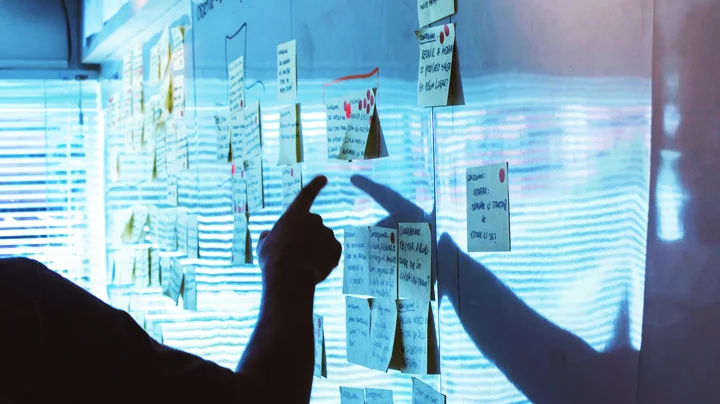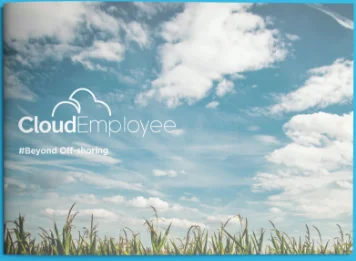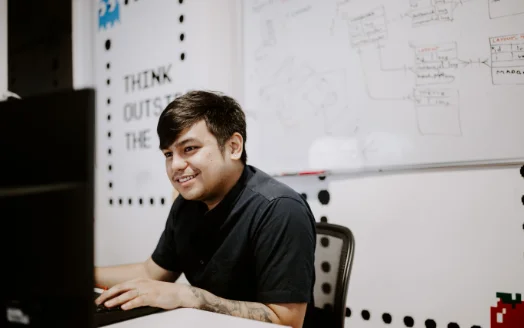Productivity is something that project managers always strive for.
But, what is productivity?
Productivity is connected to the words effectiveness and efficiency. Being effective means producing the expected result or output, while being efficient means doing work in the best way possible without wasting time and energy. If you combine both of these concepts, that equals productivity.
As such, it is the project manager’s role and responsibility to produce the intended results in the most efficient methods. However, in reality, this can be quite difficult as project managers are expected to handle and juggle client expectations, manage team resources and progress, troubleshoot issues, and know how to use project management tools, on top of other responsibilities, to produce great results.
To help out a practising or aspiring project manager, here are project management hacks you can try to increase you and your team’s overall productivity.
1. Hire the right people
“Great things in business are never done by one person. They’re done by a team of people.”
Steve Jobs
A successful project starts with the right team. As a project manager, it is also your role to choose the best people for positions in order to run your project smoothly.
In a 2017 PMI report, top companies considered their team members as their highest priority.
Hiring top-notch staff and encouraging training, project managers can expect a collaborative and productive work environment. Without a good core team, it would be difficult to run and deliver a project with problems caused by miscommunications and little mishaps. In the long run, underperforming members can cost your project time, money, and effort.
When hiring or choosing your team members, don’t be in a hurry and thoroughly weigh your candidates. Make sure you are fully aware of their qualifications, potentials and weaknesses so that you can assess and verify whether they are fit for the position and for the team you’re creating.
Imagine team members collaborating, promoting learning, recognising people for their efforts, and producing great results. That’s what you call a top team.
2. Focus on your priorities first
When making a to-do list, it’s easy to start off your day with easy or less important tasks, however, doing so can potentially make you procrastinate on the important stuff.
To avoid procrastination, start your work with the three most important and urgent tasks at hand. Before you work, discern which tasks are crucial and urgent, and list them as your highest priority.
But, be careful:
It’s easy to get caught up in the tasks that we think are important.
Popularised by Stephen Covey’s book The 7 Habits of Highly Effective People, the Eisenhower Matrix helps sort out and prioritise important and urgent tasks. Using this matrix can help you discern whether you should do, plan, delegate, or eliminate tasks.
3. Only set and attend meetings that matter
As a project manager, it is your responsibility to keep everyone updated on the project’s progress and troubleshoot issues along the way. You may need to call on your team to announce changes, or to discuss an issue.
Meetings are a great way to round up everyone to brainstorm on a solution, but let’s be honest—no one likes long, especially pointless meetings.
A study by Bain & Co partner Michael Mankins and analytics provider VoloMetrix found that senior executives and middle managers spend an average of 28 hours and 21 hours, respectively, in a meeting per week.
Imagine the amount of important work you could have done with that time.
Make sure that when you set a meeting, it’s for an important matter that needs immediate attention. Remember, you are taking you and your team’s valuable time to discuss the topic at hand, instead of working on the project. Be sure it is worth your time.
In addition, when making a company or project announcement, decide whether it’s necessary to gather everyone just to hear it. If the info isn’t that important or urgent, you can simply email your team about it or notify them via the messaging app you’re using.
During the meeting, ensure that everyone involved arrives on time. Keep information brief but clear. Also, time and manage discussions to keep the discussion concise and on-topic. At the same time, engage every member in the room so that no idea is left unheard.
Related Article: 8 Tips For More Productive Meetings
4. Use digital project management tools to your advantage
This is one of the most popular project management hacks as there are already plenty of robust project management and social collaboration tools such as Google Calendar, Asana, Slack, Trello, and Facebook Workplace, among others, that suit any project scale and model.
It’s important for project managers to familiarise and use these tools so you and your team can effectively and efficiently synchronise information across platforms. Using these tools will definitely save you time and effort as you can easily share information and track progress within your team.
However, just a bit of advice:
Only use the tools that can help with your project. Identify which tools are the best to align your team, to create a collaborative space, and track their progress. Be careful of using too many tools that its functions can overlap with other tools and also get in the way of you and your team’s work. Too many software being used can also hinder productivity and lead to a waste of time.
Related Article: A Review of the Top 5 Project Management Tools
5. Communicate efficiently
This is a simple, yet often overlooked task that drags productivity—email.
According to the Email Statistics Report, 2017-2021 by The Radicati Group, Inc., 269 billion emails are sent per day. In a different study by the same research group, an average office worker receives about 121 emails per day. That’s how much people spend their time responding to emails.
Now, let me ask you this:
Have you ever gone back and forth in an email just to set up a time and place for a meeting?
Very unproductive, right?
As a project manager, communicating with your team members, other managers, and stakeholders is part of your role for the project to move forward. However, sometimes, communicating can be quite time consuming, especially if information is not fully understood or finalised on both sides.
Highly productive project managers make it a point to reduce the need to email by sending complete and accurate information or question. That might mean a longer email, but the more precise the email is, the less time you spend on getting the information you need.
Always practice efficient email writing.
6. Delegate work effectively.
An efficient project manager knows when to call on for help.
Going back to the Eisenhower matrix, the tasks that you need to delegate are in the third quadrant which are the ‘Urgent, but Not Important’ tasks. It’s not because you’re not capable of doing the tasks at hand; it’s just doesn’t fit your means right now.
In a PMI report, 32% of the respondents consider leadership and technical skills as a high priority. For project managers, this means making full use of your time to demonstrate your skills. Let go of tedious and time-consuming tasks such as booking meetings, scheduling interviews, and the likes, and consider delegating these tasks to a freelancer or an offshore virtual assistant.
Some project managers think that they can do tasks more efficiently so they do it by themselves. The problem with this is that it doesn’t help you or the project. Doing all these unnecessary small tasks can pile up and cause too much workload and stress.
By delegating tasks to other team members, you can:
- Be more flexible with your time
- Prioritise the important and urgent matters
- Ensure quality is given in every task
As long as you properly delegate tasks to the right team members (and if you hired the best team), then you have nothing to worry about.
Related Article: 6 Major Signs You’re a Micromanager and How to Avoid Being One
7. Learn to gracefully, but firmly say “no”
“The art of leadership is saying no, not saying yes. It is very easy to say yes.”
Tony Blair
The ability to say ‘no’ is one of the most difficult, yet empowering things project managers can do. It’s one of the project management hacks that could save your team time, effort, and cost if you would have the confidence and professionalism to decline.
Here are three tips on when and how to say ‘no’:
- Make a list of things to decline - Based on your project requirements and limitations, identify the things that go over the scope of your project.
- Explain the reason clearly - Calmly and politely discuss why the client’s request isn’t possible. Present reports, if you have to, to further solidify your point.
- Propose an alternative - As it is part of your role to solve issues, be prepared to recommend an alternative solution that would be a good compromise to you and your client’s needs.
8. Write down a distraction list
Social media, emails, colleagues, noisy work environment—all of these and more are everyday distractions that disrupt our work.
One of the best life hacks for time management is the Pomodoro Technique. Developed by Francesco Cirillo, it is a method that breaks down work into intervals, usually 25 minutes at length divided by short breaks.
Part of the technique’s strategy is to make a distraction list. Often times, as we work, ideas pop up and we feel the need to act on it before we forget to do it, even if it’s just as simple as checking your email.
These ideas are important, but they don’t deserve your attention right now. The Pomodoro technique requires that you give your full undivided attention to your task during your work interval. So, instead of doing something that you remembered you need to do, you should list it down on your distraction list.
Whenever an idea arises, write down your thoughts in bullet points and come back to it later during your short break or after you have completed your important tasks.
9. Always keep track of numbers
One of the ways on how to manage a project effectively is to keep tabs on your project’s data. It is necessary for project managers to have an idea on your project’s overall progress. Knowing the numbers can help you adjust your timeline if something needs to be reconsidered. It also allows you to readily present data when a client asks for specifics about the project.
Applicable to any project, here are a few factors that can affect your project:
- Budget spent so far
- Time reports
- Number of tasks left
- Team velocity
- Holidays, leaves, and resourcing until project launch
Time and budget reports are crucial to identifying and clearly communicating issues as well as updating the project’s progress to the client. On the other hand, data on team velocity and task progress allows project managers to see issues internally such as a task taking longer than anticipated, or not enough manpower on a certain task.
Check on these factors on a weekly basis so you can see the trends and issues that might currently affect your project. It also lets you double-check on information that might have been excluded or miscommunicated, further eliminating risks later on.
After the project is finished, review the data and see where and what went wrong so you can avoid these from happening on your next project. (See #15 for more on project reviews)
10. Don’t underestimate your time
Sometimes, no matter how organised and well-planned project managers are, there are still some unforeseen factors that can ruin or pause your project.
Highly productive individuals know about the planning fallacy. It’s when people underestimate the time to finish a task. In Planning Fallacy: Why people underestimate their task completion times, the study stated that people tend to forget to consider outside factors when estimating a task.
What may take an hour of work can actually become four hours if you have not considered factors like an urgent meeting, or other factors beyond your means. Considering interruptions and contingency plans can help project managers adapt to situations and solve problems as they arise.
11. Take short breaks
A research by Tony Schwartz, founder of The Energy Project, discovered that “humans naturally move from full focus and energy to physiological fatigue every 90 minutes.” Our bodies send signals about this, but we just usually suppress it by drinking coffee, energy drinks, and etc. until we don’t have energy left—and that’s not good.
A time tracking software by The Draugiem Group in Latvia found that the most productive employees actually worked less than others and took more breaks. This productive individuals worked an average of 52 minutes and had breaks of 17 minutes long.
Nobody, not even the most productive person in the world, can work for 8 hours straight. Try out the Pomodoro Techniques mentioned above, learn to take short breaks, stand up, take a walk or stretch out. This is one of the project management hacks that’s good for your brain, body and mood.
But, a bit of warning:
It’s easy to call distractions as ‘taking a break’. To avoid falling into this trap, set scheduled short and long breaks. This will keep your mind fresh throughout the day.
Related Article: 11 signs you lack work-life balance
12. Make fewer decisions
In an interview, former US President Barack Obama told Vanity Fair that he only wears gray or blue suits. Obama said, “I’m trying to pare down decisions. I don’t want to make decisions about what I’m eating or wearing. Because I have too many other decisions to make. ”
If you want to be more productive, consider minimising everyday decisions like what to eat, and what to do next, among others. Fewer decision-making can lead to greater satisfaction and better results, as found by researchers at Columbia University.
To get rid of unnecessary decisions, create a morning routine, plan your day, and actually stick to it. Remember to have room for unexpected events to make your day more flexible. Also, automate repetitive processes as much as you can, and use digital tools to help you work more efficiently.
13. Stop multitasking
Sometimes, a project manager’s job requires them to juggle a few tasks which can be quite overwhelming. In these cases, seriously, avoid multitasking.
Studies have already shown that multitasking is actually counterproductive. A study by Stanford University’s Communication Between Humans and Interactive Media Lab found that multitasking is inefficient and may actually impair our cognitive control.
Another study by the Journal of Experimental Psychology: Human Perception and Performance said that multitasking decreases our productivity by 40%.
In addition, another study by University of Utah Psychologist David Strayer suggests that only 2% of the population can multitask and that these “supertaskers are true outliers.”
Multitasking interrupts tasks instead of finishing tasks one after the other. It gives us the illusion that we’re doing more by doing a lot of things all at once. Doing more doesn’t mean you’re doing good. Always value the quality of work being done instead of the quantity of tasks finished.
14. Check on how your team is doing
This seems obvious but just having a little chat with them can help project managers get to know their team members better. Ask how they are with their work and even in life.
Checking in with your team can significantly improve business performance. According to a Mercer | Sirota study, stock prices increased by 16% at companies with high morale, compared to only 3% with companies with low morale.
What many project managers don’t realise is that project management is also people management. Engagement builds trust and a team that trusts each other works well together. Team members will be more comfortable opening up about minor issues to project managers and other team members.
Here are some of the things project managers can do to create a well-engaged team:
- Have a weekly catch up with them - Set up a time once a week to ask them about their tasks for the week, their progress, and any issues that they have encountered that needs attention or brainstorming. It’s also good to ask about any upcoming leaves your members might have.
- Do a monthly catch up with each member - This one’s a more casual and intimate way to get to know your members and a good way to ask them how they’re handling work and how they are currently in life.
- Greet them - This builds familiarity between you and your team member. Project managers can also try to make casual small talk if time permits.
- Allow your team to share non-work related topics in your group chat - Either it's asking what everyone is having for lunch, sharing some funny posts, or sharing good articles, allow your team to do so in your group chat. You can specifically create a group chat for off-topic ideas just so it doesn’t mix up with work-related stuff. Again, this creates familiarity and a friendly atmosphere within the team.
Ultimately, your goal is to build good communication habits so that your team can easily reach out to you or the other team members.
15. Review the project after completion
This is one of the project management hacks that can help you learn and can save your next project. Project reviews are a great way to identify areas for improvement and think of ways on how to prevent these mistakes from carrying over to your next project.
Here are some key questions to ask and take note of when doing a post-project review:
- What were the good points? - Identify which tasks and processes were done well.
- What could be improved? - Pinpoint tasks that could have been done better with more time or effort.
- Which processes or plans that didn’t work? - Identifying why these didn’t work is a must. You may need to rethink how certain projects will run as some processes may have to be dropped for further efficiency.
- What will you do now? - With the information you have, what are the steps you should take to prevent issues and preserve processes that work well?
When having a project review session, try to get as many team members and stakeholders to identify problems and to brainstorm. If this goes well, it will be a great learning experience for all.
Again:
Going back to the project review’s purpose, the session is meant to improve on tasks and processes—not to point fingers. Be careful and learn to manage discussions.
What’s the secret to outsourcing top-notch offshore developers? Hiring great tech talents with us today. Learn how Cloud Employee works, see our Developer Pricing Guide, or talk to us. You can hire dedicated offshore developers with us across many technologies.
Work with world leading tech businesses
We connect high-performing software engineer talent in the Philippines with some of the world’s leading and most innovative Tech companies.
Submit CV













